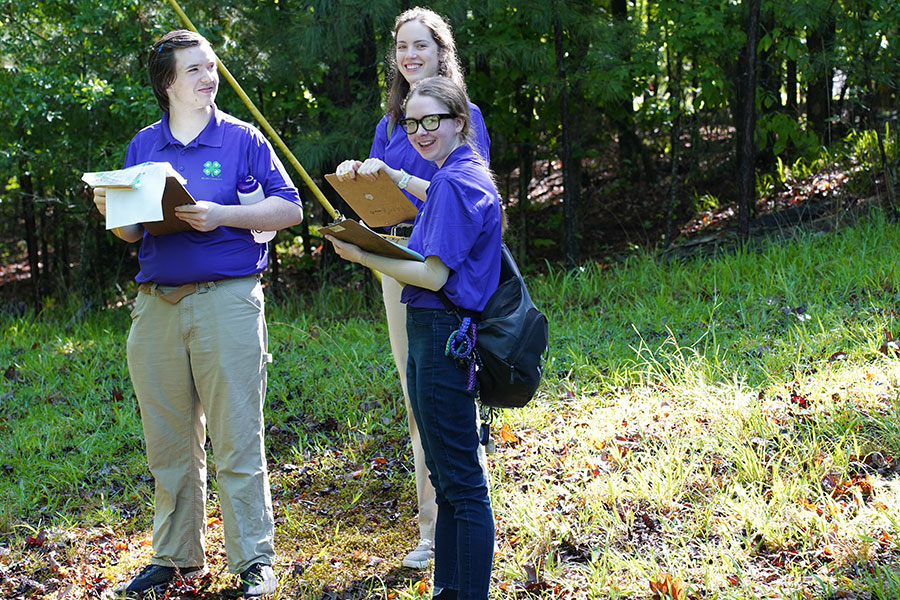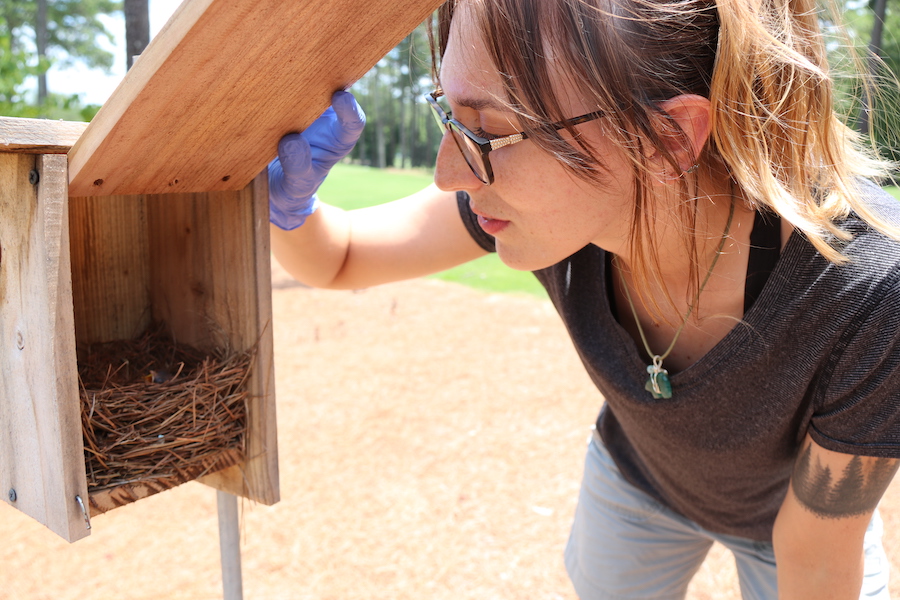
Many studies have shown that prenatal stress in mothers can be linked to adverse outcomes in the physical, emotional, cognitive and behavioral well-being of children. Now a study at the University of Georgia is examining how pre-hatch exposure to the stress-associated hormone corticosterone influences immune function in baby bluebirds.
Taylor Miller, a doctoral student in the Department of Poultry Science at the College of Agricultural and Environmental Sciences (CAES), has been monitoring more than 50 bluebird boxes at the UGA Golf Course and more than 40 boxes in other locations on and around UGA’s Athens campus to test the immune response of newly hatched birds to corticosterone.
Corticosterone is the major adrenal stress hormone produced by bluebirds and is an important stress-induced modulator of several physiological functions in birds, similar to the function of cortisol, the main stress hormone in humans, Miller said.
How maternal stress influences offspring
As in other egg-laying species, bluebird mothers are exposed to stress from factors ranging from the availability of food to the influence of humans on their ecosystems. An increase of corticosterone in the mother correlates to an increase of the hormone in the eggs she lays.
This is similar to the phenomenon of bluebirds producing more testosterone when there is greater competition for nesting sites and resources, Miller explained. If a mother bird is in an environment where other birds often intrude into her territory, that mother bird will produce more testosterone. This testosterone is then deposited in the eggs she lays, making the offspring larger and more aggressive, helping them to grow up to defend their own territory more effectively.
Miller is seeking to determine how prenatal corticosterone exposure due to stress in the mother impacts the offspring.
“It is important to emphasize the volatile nature of the environment around the world today as environmental change happens. It is important to know how stressed these birds are, what they are having to overcome, how they are being affected and how their offspring are being affected,” she said.
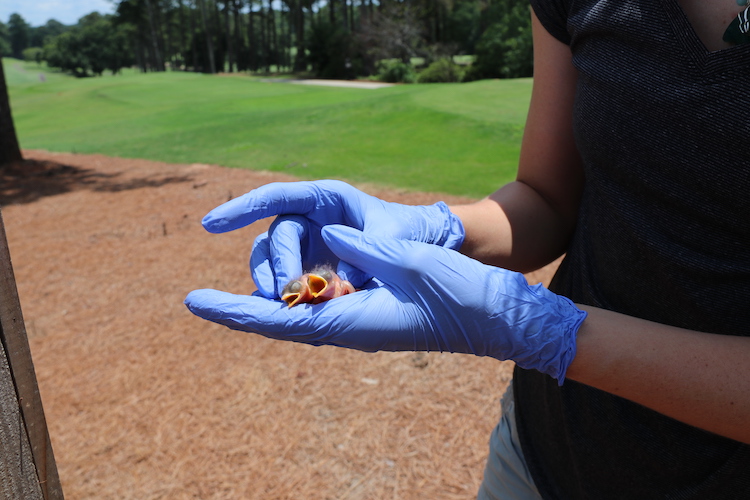
Baby birds are naturally exposed to pathogens and parasites as nestlings, and anthropogenic factors — the encroachment of humans on wild habitats — are also contributing to disease in animals.
“All nestlings have innate immunity, that is the first line of defense,” Miller said. “We want to know how prenatal corticosterone exposure impacts the immune response.”
Measuring immune response
To test how increased corticosterone may affect the birds’ offspring, Miller monitors the bluebird boxes daily, searching for newly laid eggs. She injects some of the eggs in each nest with corticosterone, while other eggs are injected with a control solution that does not include corticosterone.
Bluebirds are an ideal species for the study because they are cavity-nesting species — they will nest in boxes researchers place in the territories where they live and can have several nestings, laying two to three clutches of eggs between early spring and the end of the breeding period in mid to late summer, Miller said.
“We take blood samples from the birds at 10 days after hatching to measure immune function in relation to prenatal corticosterone exposure, which is known to program offspring behavior and growth. Morphological measurements — such as growth measurements at different ages — are taken, beginning the day after hatch, up until they fledge from the nest,” she said.
Baby birds are protected by their innate immune systems and maternal antibodies, and testing for the influence of corticosterone and other hormones gives a glimpse into this immune response in baby birds.
“This research on a broad scope is to determine the effect of corticosterone on innate immunity in nestlings,” she said. “Innate immunological function is measured because this is what they are relying on in a new environment — until their adaptive immune response develops — and it is important to fight off the pathogens, bacteria and parasites they will encounter as babies. This immunity is important for nestlings to survive.”
The blood samples are tested with a comprehensive panel of immunological assays to determine the ability of the nestlings’ cells to kill bacteria, such as E. coli, during the immune response.
“We test for as many parameters as possible so we can make a more educated conclusion on how the immune response is being affected,” Miller said.
Developmental impact
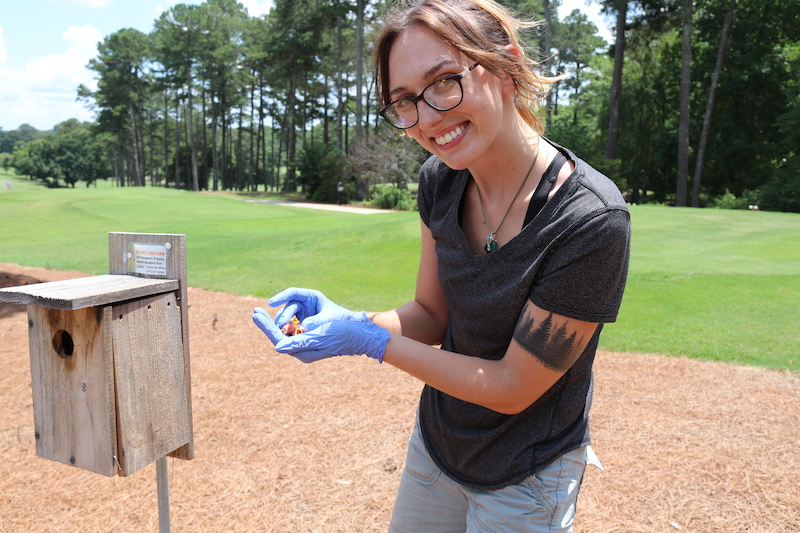
The data is compared against measurements of morphological data about the chicks — including size and health — from hatch through fledging. The birds are also given an injection of PHA, a natural toxin found in many foods, under the skin to measure the birds’ immune response, including swelling.
“As with many things in nature, certain types of maternal effects can act as a benefit, but that does not mean there are no detriments. There are always tradeoffs,” Miller said. “It is the adaptive value of prenatal exposure to corticosterone that is important. Why are they depositing it? It is not conscious, but stressed mothers with elevated levels of plasma corticosterone will deposit it in the egg.”
Corticosterone is an important stress-induced hormone that induces physiological changes in the birds that are important in the fight or flight response and in the birds’ ability to utilize more glucose in a stressful situation, giving them the energy they need to react in a stressful environment.
“We believe that this perhaps adjusts offspring quality to match maternal investment. In stressful environments, mother birds will prioritize self-preservation over care for offspring,” Miller said. “Prenatal corticosterone can cause offspring to grow more slowly, matching what the offspring need to what the mother can provide.”
Because bird behavior is also influenced by prenatal corticosterone exposure, Miller seeks to discover whether the offspring of stressed mothers may be able to handle stress better when they leave the nest.
“Prenatal exposure may cause the hypothalamus in the offspring to be more reactive to stressful stimuli. If a prenatally stressed baby mounts a stress response quicker than one that was not exposed, that exposure may help those offspring adapt to the environment they are born into,” Miller said. “If they can mount that stress response quicker, they might be able to get away from those stressors. Corticosterone being deposited prenatally is potentially preparing their progeny to experience and cope with stressors, like more predators.”
This research will set the groundwork for possible further studies that could lead to information impacting human health.
“All of the recent outbreaks of note in humans are zoonotic diseases. As animals’ environment is wiped out by development, humans are encroaching on animals and there is transmission and spillover of disease,” Miller said. “It is more difficult for a disease to jump from birds to humans, but the effects of disease on populations of birds are important indicators. Much of what we know in other species we first have learned from birds, an ancient evolved species, and might prompt more research in placental animals.”
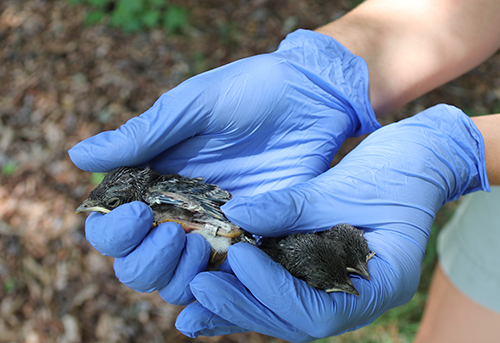
A natural laboratory
Scott Griffith, assistant superintendent for the UGA Golf Course, said it is not the first time the 250-acre course has been used for research. Miller’s advisor, Associate Professor Kristen Navara, previous advised another student who performed bluebird research at the course, in addition to turfgrass research by faculty in the Department of Crop and Soil Sciences at CAES. Researchers from UGA’s Warnell School of Forestry also perform research at the site, which includes about 150 acres of undisturbed wilderness.
“Our mission is to serve the students, faculty and staff at UGA in any way we can, either as a refuge and stress reducer and also by providing a place for research to conduct their work,” said Griffith, who estimates that the course hosts an average of three research projects per year. “We have a lot of land out here that could be used for research and I’d love for more people to know about it.”
Griffith has been working to obtain Audubon Society certification as a wildlife sanctuary for the course, performing a wildlife inventory assessment of the course with Assistant Professor Richard Hall in the Odum School of Ecology at UGA, which identified more than 100 species of birds on the property. Griffith has also worked to reduce pesticide use on the course to improve water quality and incorporate sustainable land-management practices.
“The majority of my bluebird boxes are at the course,” Miller said.



